Australia, like all islands, is an isolated laboratory of sorts, one that offers a look at what the world might be like under different evolutionary pressures. The rest of the world at large operates in much the same way, no matter where you go; the placental mammals (cats, dogs, deer, antelope, etc.) dominate top tier niches. But Australia shows us an alternative world, one dominated by marsupial mammals, with a rich assortment of birds and reptiles unlike anything anywhere else on the planet. Today we’re looking at Safari Ltd.’s “Land Down Under TOOB,” a celebration of Australia’s most iconic wildlife. We’ll go over the TOOB piece by piece on an individual basis before critiquing the TOOB as a whole.

Dingo: We’ll start our look at this toob with the dingo (Canis lupus dingo), an animal synonymous with Australia, but the dingo isn’t really a native species. Like other domestic dog breeds the dingo is a descendent of wolves, hence the scientific name. Skeletal remains indicate that the dingo has been in Australia for 3,450 years but was brought to the continent by its first human inhabitants; it was a domesticated animal that had gone feral. I’m not surprised that the dingo is included in this toob but I would have preferred a different species endemic to Australia. This dingo is well detailed and presented in a static pose with the head looking rightward. Its anatomy also indicates that it’s a male.
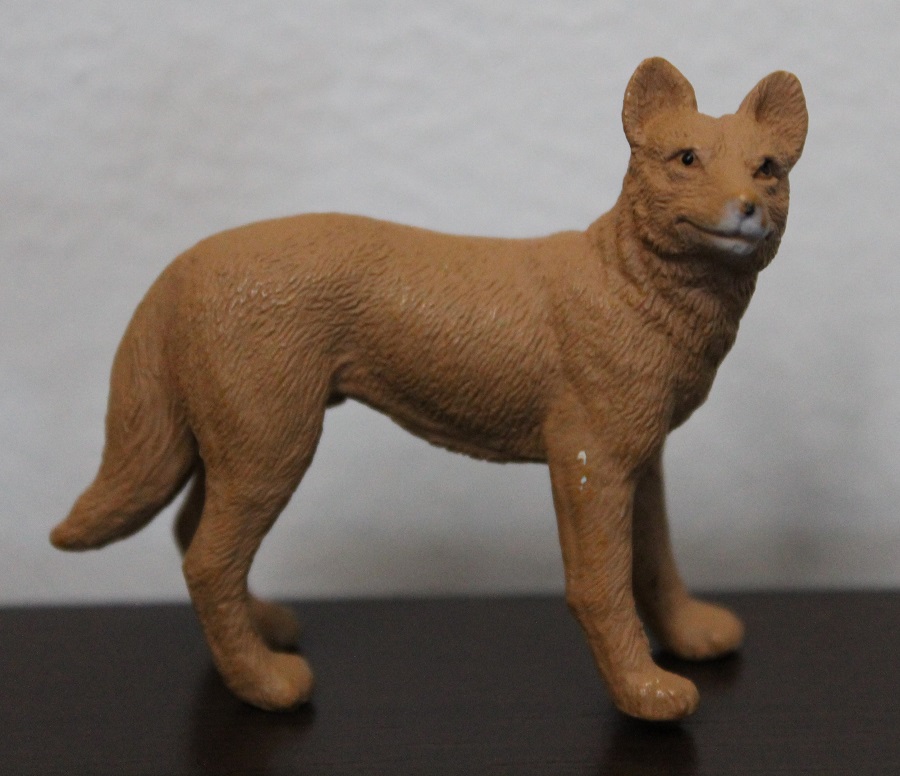
Kangaroo: Aside from being labeled as a kangaroo this figure doesn’t give any information on what species of kangaroo it’s supposed to be. Not being well versed in macropodidae I would speculate that it’s a red kangaroo (Osphanter rufus), the largest and one of the most familiar kangaroo species. The body proportions and coloration of the figure lend support to this identification. The figure is posed in an upright posture, supported by the tail, with head held high. It’s a fine little figure of a kangaroo but what makes it really special is the tiny little Joey peaking out of the pouch which looks astonishingly good for its size. No collection of Australian wildlife would be complete without a kangaroo.
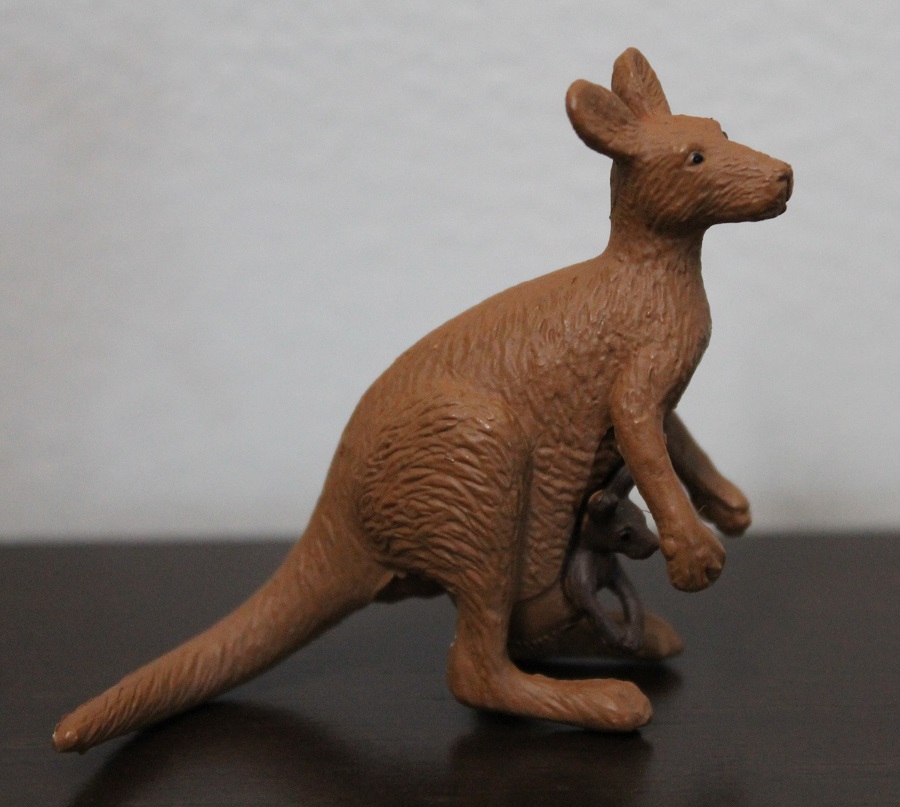
Wombat: Three species of wombat can be found in Australia and this one appears to represent the common wombat (Vombatus ursinus). Wombats occupy a similar niche to burrowing rodents elsewhere in the world; even their dentition is similar to the gnawing teeth of rodents. This wombat is an adorable and stocky fellow. Although many plush wombats exist there aren’t very many plastic renditions so this one is a welcome addition to the toob.
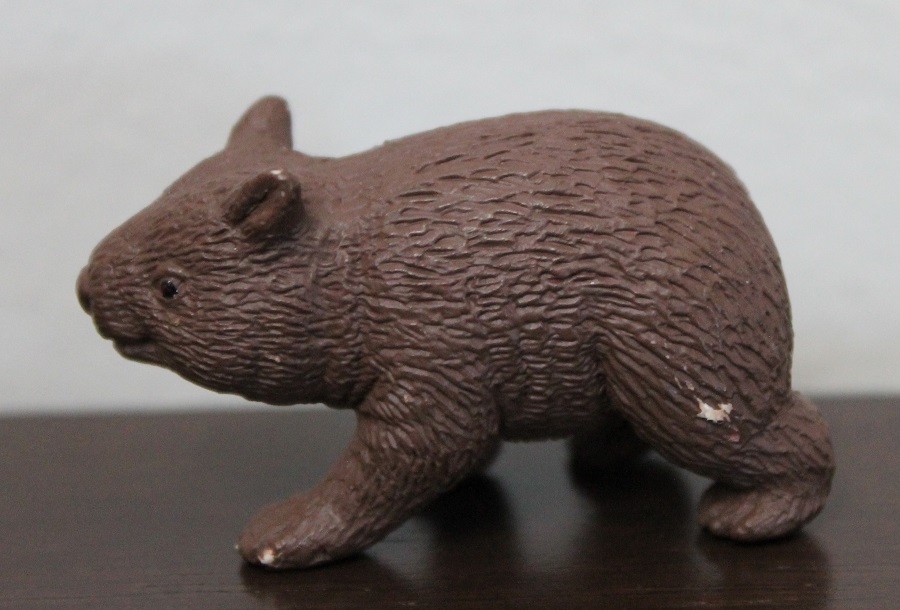
Koala: The inclusion of the koala (Phascolarctos cinereus) is not at all surprising here. It’s as essential to the toob as the kangaroo is. Though often called koala bears they’re not at all related to true bears, you’re more closely related to something like a grizzly than a koala is. Koalas are most closely related to wombats with which they make up the vombatiforme suborder. This koala is presented with a Joey clinging to her back. Although the baby is undeniably cute I find there’s something off about the posture and proportions of the adult.
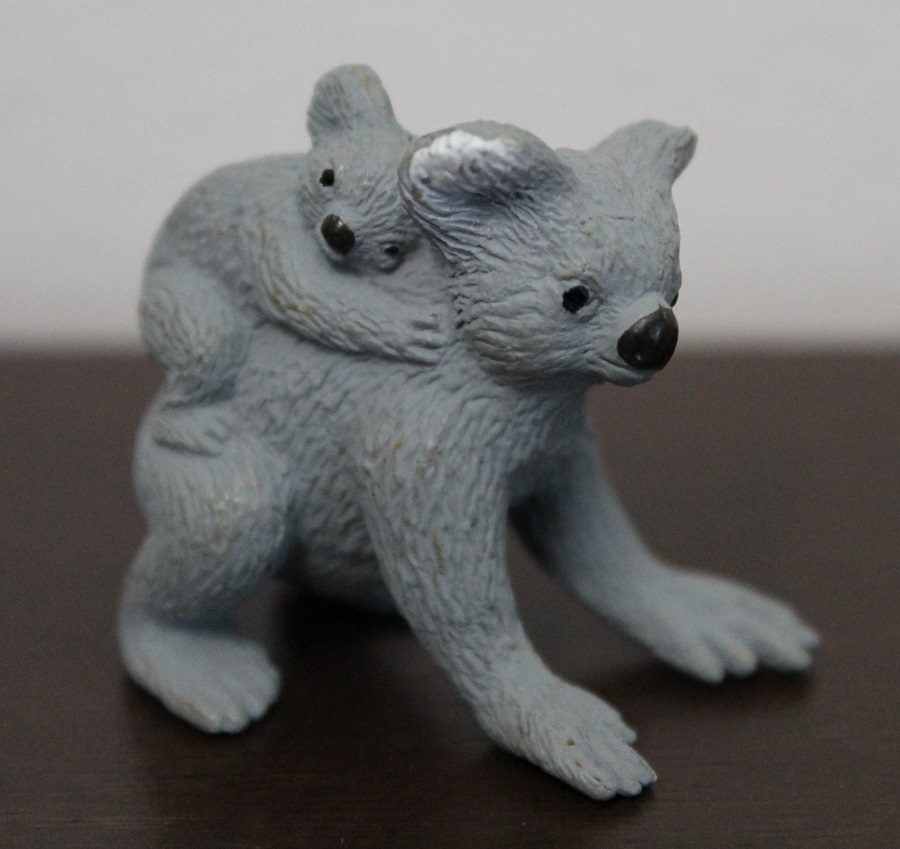
Tasmanian Devil: The Tasmanian devil (Sarcophilus harrisii) is the largest extant carnivorous marsupial and only found on Tasmania. It was once present on mainland Australia but has been extirpated and it seems likely that the introduction of dingos played a role in this. This devil is presented in a static pose with its mouth agape. Aside from the white V shape on the neck the rest of the toy is painted black, including the ears, teeth, and tongue. The sculpt itself is quite nice though.

Platypus: Australia isn’t just home to marsupial and placental mammals but also the world’s only extant monotremes; egg-laying mammals. The platypus (Ornithorhynchus anatinus) seems almost like a chimera, with body parts taken from various unrelated animals but any resemblance to other species is purely due to convergent evolution. The “duck bill” for example is composed of leathery skin, not hard keratin like a bird beak. This platypus is posed in a swimming posture with the limbs sweeping back behind the animal. The body is painted brown, bill gray, and eyes black. I quite like this little fellow.

Cockatoo: Moving away from mammals it’s time to look at some of Australia’s equally enigmatic sauropsids; reptiles and birds. The sulphur-crested cockatoo (Cacatua galerita) is popular around the world as a pet but naturally occurs in Australia. A lot of popular pet birds hail from down under, including parakeets (budgerigars), and zebra finches. This bird is presented with wings and tail feathers spread out, and yellow head crest on full display. Although the sculpting detail is fantastic this toy does suffer from stability issues, tipping over unless propped up. EDIT: Apparently not all the cockatoos have the same stability problem as mine.
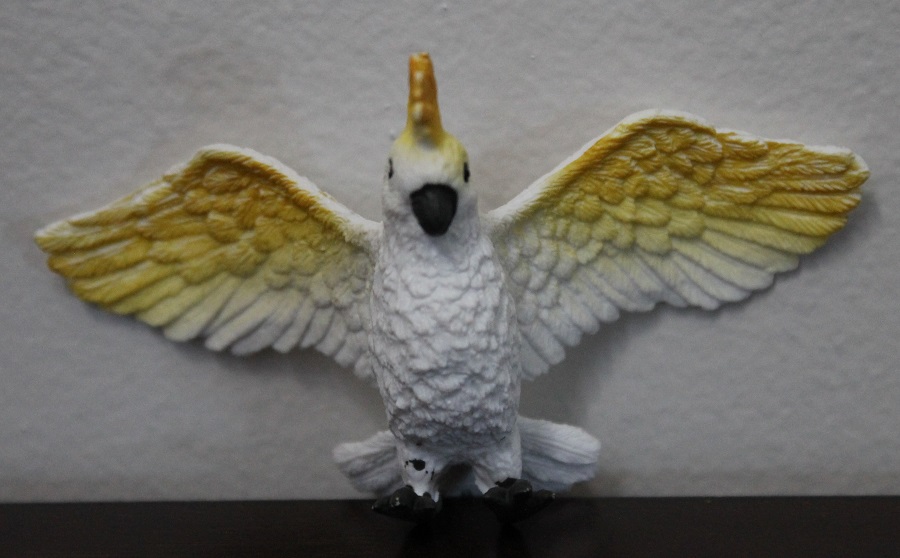
Emu: In terms of height the emu (Dromaius novaehollandiae) is the second largest bird on the planet and ranges widely over the mainland of Australia. There are only two birds in this toob and although Australia is home to many other unique species the inclusion of the emu is basically a requirement. This one is standing alert on a base and the body is covered in long, wispy feathers. The body, legs, and base are all painted the same brown color and the head and beak are painted white.
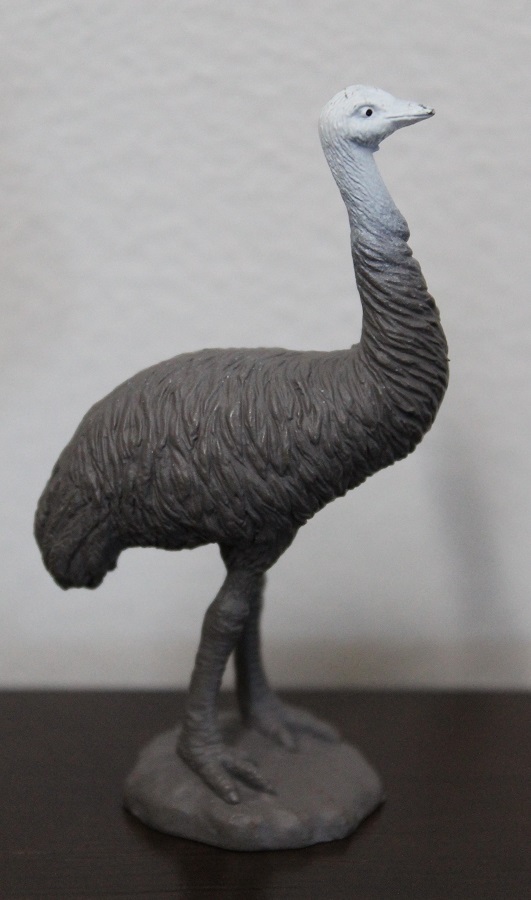
Crocodile: Aside from the dingo every animal in this toob is unique only to Australia, occurring naturally nowhere else in the world. The saltwater crocodile (Crocodylus porosus) however occurs throughout Southeast Asian islands as well as mainland south and Southeast Asia. But nowhere is it more famous than in Australia, a symbol of Oz’s untamed and treacherous wilderness. Crocodiles are popular as toys but this one in particular is quite exceptional, presented in a high-walking stance with the legs lifting the body up off the ground. For this reason, and because of the exquisite fine detail on the head, scales, and osteoderms along the back, this has to be my personal favorite figure in the toob.

Taipan: Next up we have one of Australia’s many highly venomous snakes represented, the taipan (Oxyuranus spp.). There are actually three species of taipan with one (O. temporalis) only having been described in 2007. The inland taipan (O. microlepidotus) is renowned for being the world’s most venomous snake while the coastal taipan (O. scutellatus) is the longest venomous snake in Australia. I’m inclined to think that this toy represents the inland taipan but because the details are so minimal I’m disinclined to make a more definitive identification. That’s not to say the figure is bad, far from it, for its size this is a very well sculpted snake. Part of the issue is the color as this toy is painted entirely in the same shade of brown. This is the only toy taipan I’m aware of and a welcome addition to this toob.
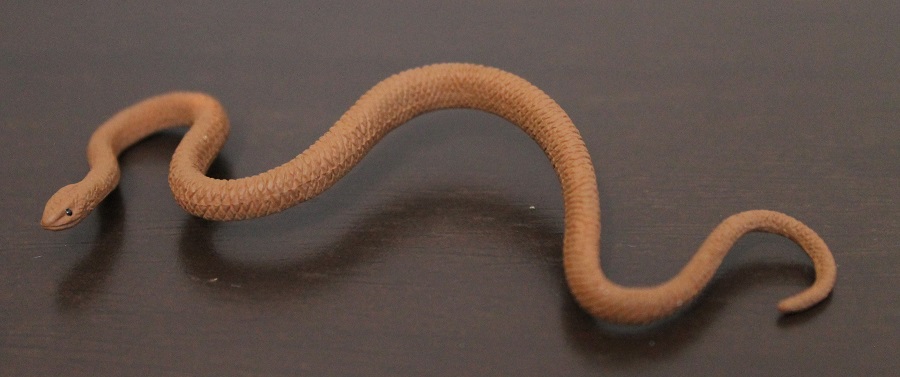
Frilled Lizard: The frilled lizard (Chlamydosaurus kingii) might be the most quintessential and recognizable lizard that Australia has to offer. Although they’re really quite small at about 2’ (60 cm) they have a most unusual and intimidating display where they gape their mouth, open up the frill around their neck, and even run bipedally. So threatening is the display that is was applied to the Dilophosaurus in Jurassic Park. This frilled lizard is presented in display. The mouth is open, frill extended, and it’s standing on its hind limbs. There’s nothing to be afraid of here though, the toy is quite cute in fact with its beady little black eyes and toothless, pink mouth.
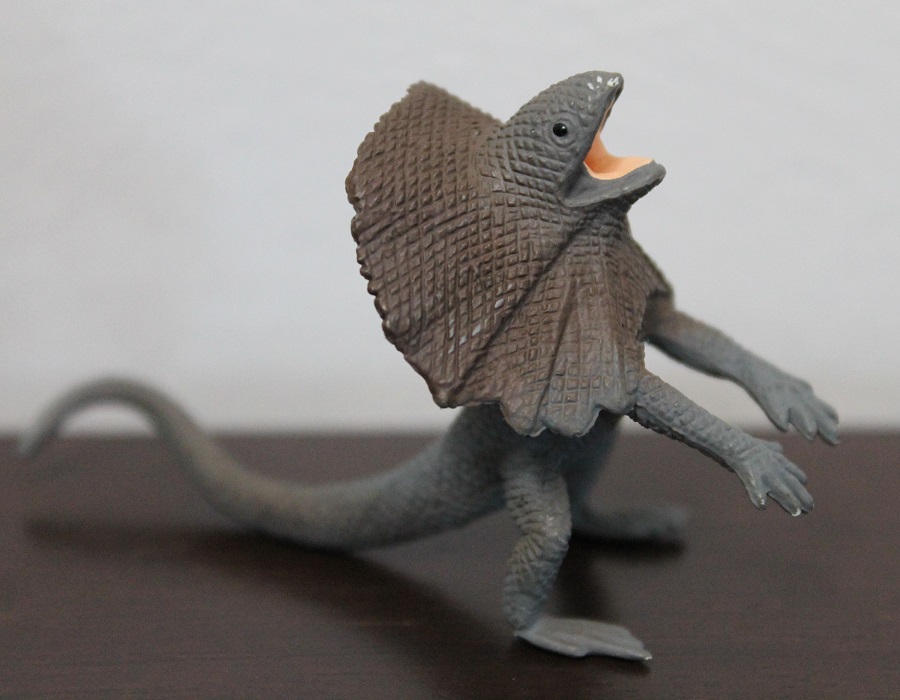
Overall I highly recommend this TOOB. The sculpts are all pretty good with only a few suffering from lackluster paint jobs and one from stability issues. Because Australia is home to so many unique animals it would have been nice to have some included in lieu of the larger, more charismatic animals; perhaps a wallaby in place of the kangaroo, or a quoll in place of the dingo but it certainly succeeds at highlighting some of the continents most popular animals.
Disclaimer: links to Ebay and Amazon on the AnimalToyBlog are affiliate links, so we make a small commission if you use them. Thanks for supporting us!




I do not have this TOOB, nor probably will I get it (as I have good exemplars for each species), but it is nicely done. For the size, the animals are pretty good with nice textural detail. I really like that the crocodile is walking upright! I have seen other versions online with an aboriginal human. Is that a different release, or a customized set?
I don’t know if that’s a customized set or not, the toob I have is the only version I’ve ever seen.
I have two of these cockatoos (one from this set and one from the exotic birds set) and both stand. Yours probably got warped in the package, it happens often with these toobs.
Thanks for the info, I edited my review to reflect this new information.
Google images suggests a previous release that included the guide mentioned in bmathison1972’s comment as well as paint for the emu and platypus’ feet, a white underbelly for the koala, and the inner mouth of the Tasmanian devil.
https://i5.walmartimages.com/asr/83eeb70a-0f46-42ae-8b93-23e544595ff7_1.1017a0c6d3981f91a49ab19a620e244a.jpeg
Shame as many of these sculpts are undermined by lack of paint, especially the emu and the devil.
I absolutely think there is room for a second Australia doob — cassowary, kookaburra, and echidna all provide some unique species to start with, and we could definitely use another macropod to go with this kangaroo. Thylacine would be a great inclusion but they could easily save it for an extinct toob…